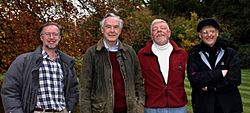John Hemming (explorer) facts for kids
Quick facts for kids
John Hemming
|
|
|---|---|

Andean explorers Hugh Thompson, John Hemming, Vince Lee, and John Beauclerk in 2010
|
|
| Born |
John Henry Hemming
5 January 1935 Vancouver, British Columbia, Canada
|
| Alma mater | |
| Occupation | |
| Spouse(s) |
Susan (Sukie) Babington Smith
(m. 1979) |
John Henry Hemming (born January 5, 1935) is a famous historian, explorer, and expert. He knows a lot about the Incas and the native people of the Amazon basin.
Contents
Early Life and Learning
John Hemming was born in Vancouver, Canada, on January 5, 1935. His father sent his mother, Alice Hemming, to Canada before World War II began. John and his sister Louisa moved back to London when he was just two months old.
He went to school in the United Kingdom at Eton College. Later, he studied in Canada at McGill University. He then earned a special degree called a doctorate from Oxford University. He also became an honorary fellow at Magdalen College, Oxford.
Adventures and Discoveries
Exploring the Amazon
In 1961, John Hemming went on an exciting trip called the Iriri River Expedition. He explored unknown parts of central Brazil with friends from Oxford. The Brazilian mapping agency helped them map these new forests and rivers. They even got to name some of the places they found!
However, after four months, an unknown group of native people found their trail. Sadly, one of John's friends, Richard Mason, was killed. He was the last Englishman to be killed by a tribe that had never met outsiders before. His body was taken out of the jungle and buried in Brazil. The tribe, called the Panará, was later contacted in 1973. John Hemming visited them in 1998.
Writing About the Incas
John Hemming's first book, The Conquest of the Incas, came out in 1970. It is still a very popular book today. This book won important awards like the Robert Pitman Literary Prize. Before writing it, John spent a whole year traveling all over Peru.
He was also the chairman of the Anglo-Peruvian Society for many years. Peru has given him two of its highest awards: El Sol del Peru ('The Sun of Peru') and the Grand Cross of the Orden al Merito Publico (Order of Merit). He also wrote Monuments of the Incas with photographer Edward Ranney. This book is about the amazing buildings of the Incas in Peru. He also inspired and became friends with Vince Lee, another explorer of the Andes mountains.
Studying Brazilian Tribes
Because of his trip on the Iriri River, John Hemming became very interested in the native people of Brazil. He went on many expeditions and visited 45 different tribes across Brazil. He was even there when Brazilian teams made the first face-to-face contact with four of these tribes.
Over 26 years, he wrote a three-book series about the native people and exploration of the Brazilian Amazon. These books are:
- Red Gold (1978): This book covers the years from 1500 to 1760.
- Amazon Frontier (1985): This book covers the years from 1760 to 1910.
- Die If You Must (2004): This book describes how the tribes changed during the 20th century.
Together, these three books are over 2,100 pages long!
Leading the Royal Geographical Society
In 1975, John Hemming became the director of the Royal Geographical Society. This is a very important group for explorers and geographers. He held this job until 1996.
He personally led a big project called the Maracá Rainforest Project in Brazil (1987–88). About 200 scientists and experts worked on this project. It was the largest research project in the Amazon organized by any European country. They worked with Brazilian researchers to study the rainforest. For his work on this project, John Hemming received the RGS's Founder's Medal. He also received awards from Brazil and other geographical societies.
In April 2008, his book Tree of Rivers: The Story of the Amazon was published. It was called a "definitive" book on the Amazon. He also wrote Naturalists in Paradise. Wallace, Bates and Spruce in the Amazon in 2015.
Family Life
In 1979, John Hemming married Susan (Sukie) Babington Smith. She worked for many years at The National Trust and later at the British Museum. They have two children: Beatrice, who was born in 1981 and is a publisher, and Henry Hemming, who is a writer.
Awards and Recognition
John Hemming has received many honors for his work. In 1994, the British government made him a Companion of the Order of St Michael and St George (CMG). In 2013, he became a Fellow of the Royal Society of Literature.
In August 2018, he received the President's Medal from the British Academy. This award was for his important work on the history and cultures of Brazil and Peru. It also recognized his efforts to protect endangered societies.

